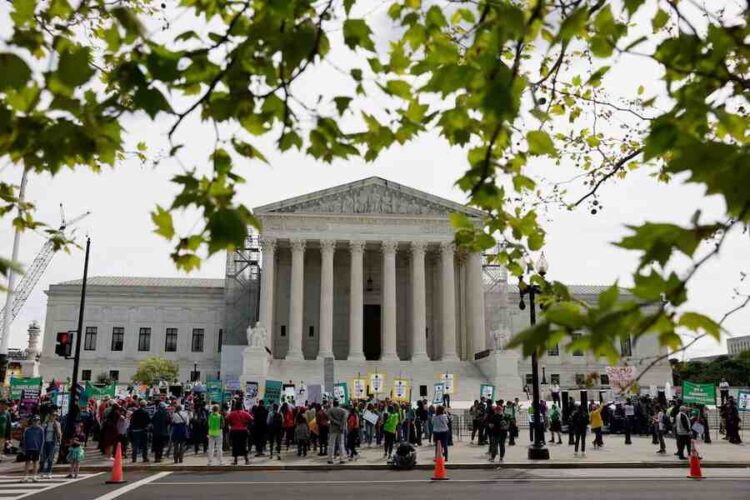In a session underscored by profound ideological divides, the U.S. Supreme Court convened on Wednesday to deliberate a pivotal legal battle. This case juxtaposes Idaho’s stringent abortion legislation against the federal Emergency Medical Treatment and Labor Act (EMTALA) of 1986.
The courtroom’s atmosphere was charged with the gravity of the issue, reflecting the broader national dialogue that has intensified since the Supreme Court’s landmark 2022 decision to overturn Roe v. Wade. This reversal not only returned the power to regulate abortions to state legislatures but also ignited a national reevaluation of abortion laws, leading to the enactment of some of the most restrictive measures in several states.
The Idaho case is particularly significant as it tests the boundaries between state sovereignty in healthcare regulation and federally mandated patient care standards. It serves as a crucial examination of how far state laws can go in restricting abortion access when they potentially conflict with federal mandates designed to protect patients’ rights to emergency medical care.
As the justices weighed arguments, the implications of their decision promised to resonate widely, potentially setting precedents that could influence abortion rights and emergency healthcare across the United States for years to come.
The Core Of The Conflict
At the crux of this judicial examination is the critical question of whether the Emergency Medical Treatment and Labor Act (EMTALA), a federal law designed to ensure that patients receive necessary emergency medical care, should supersede Idaho’s rigorous abortion restrictions.
This conflict arises in nuanced medical scenarios where a pregnant woman’s health is severely at risk, yet her situation does not immediately threaten her life. Idaho’s stringent law, which came into effect following the Supreme Court’s reversal of Roe v. Wade, sharply limits the provision of abortions, strictly permitting them only when the mother’s life is directly endangered.
This legal structure places immense pressure on healthcare providers. Physicians are caught in a moral and professional quandary, forced to navigate between adhering to federal mandates that prioritize patient health and a state law that restricts their clinical judgment.
The potential for severe legal repercussions for doctors — including criminal charges and the possibility of losing their medical licenses — adds a layer of complexity and fear to every decision made in emergency rooms across Idaho.
The debate touches on broader ethical and legal issues. It challenges the interpretation and reach of federal law versus state law, questioning whether the right to life for the unborn should uniformly override the health and autonomy of the mother in non-life-threatening circumstances. As such, this conflict not only tests legal boundaries but also delves into deep philosophical questions about the rights of women versus the rights of the unborn, setting the stage for a landmark decision that could redefine healthcare and abortion rights in America.
Federal vs. State Oversight On Medical Emergencies
U.S. Solicitor General Elizabeth Prelogar, representing the Biden administration, presented a compelling argument emphasizing that EMTALA was meticulously crafted to ensure the provision of necessary emergency medical care, effectively superseding any state-imposed limitations.
This federal law, Prelogar argued, establishes a comprehensive national standard of care that is vital in managing medical emergencies, including complex pregnancy-related complications. These emergencies often require immediate interventions that could be inhibited by restrictive state laws, potentially putting patients’ lives at risk.
Prelogar highlighted that EMTALA’s overarching goal is to safeguard patient health across all states, ensuring that everyone receives critical care when needed, free from the variances in state legislation that might not prioritize immediate medical outcomes.
In stark contrast, representatives from Idaho defended the state’s strict abortion legislation, arguing that it aligns with the values and democratic rights of the state to govern its own medical practices.
This perspective is particularly grounded in the aftermath of the Supreme Court’s decision which decentralized the regulation of abortion, entrusting states with greater autonomy over such matters.
Idaho’s officials contended that their law carefully balances the protection of unborn lives with compliance to federal mandates, asserting that it represents a lawful and moral exercise of state sovereignty in healthcare regulation.
They maintained that the state law embodies the community’s values and ethical standards, which prioritize the preservation of life from conception, asserting that these principles should not be overridden by federal interventions unless necessary.
The Judicial Divide And Deliberations
The liberal justices, led by Justice Elena Kagan and Sonia Sotomayor, challenged Idaho’s stringent measures, questioning the ethical and practical implications of a law that compels women to seek medical interventions outside their home state. They highlighted scenarios where women faced severe health risks that were not immediately life-threatening but required urgent medical intervention, including abortions, to prevent serious long-term health consequences.
The Court’s conservative faction, including Justice Samuel Alito, voiced concerns about the expansive interpretation of federal laws like EMTALA, suggesting that such interpretations might impinge upon states’ rights.
They questioned whether EMTALA was indeed intended to cover abortion services or if it was primarily focused on preventing patient dumping, the practice of turning away uninsured or financially disadvantaged patients from emergency rooms.
The legal uncertainties and stringent conditions imposed by Idaho’s law have placed medical professionals in precarious positions, forcing them to navigate between complying with federal health mandates and adhering to state laws. This has not only led to ethical dilemmas but also practical ones, where doctors must decide how close to death a woman must be before they can legally intervene without facing criminal charges.
The ruling of this case has potential national implications, as it could set precedents for how states can regulate abortions and how federal emergency health mandates are interpreted in conjunction with state laws.
A decision favoring Idaho could embolden other states to adopt similar restrictive measures, potentially leading to a fragmented landscape of healthcare rights across the country. Conversely, a ruling that upholds EMTALA’s authority over state laws would reinforce the federal government’s role in safeguarding emergency medical care, ensuring that women across the United States have access to necessary medical interventions regardless of local abortion laws.
As the Supreme Court deliberates on this pivotal case, the outcome remains eagerly anticipated by both advocates and opponents of abortion rights. The decision will undoubtedly have profound impacts on the legal frameworks governing abortion, the practice of medicine, and the intricate balance between state and federal powers in regulating healthcare and protecting patient rights.










